八年级上册unit不定代词的用法
- 格式:ppt
- 大小:191.50 KB
- 文档页数:7

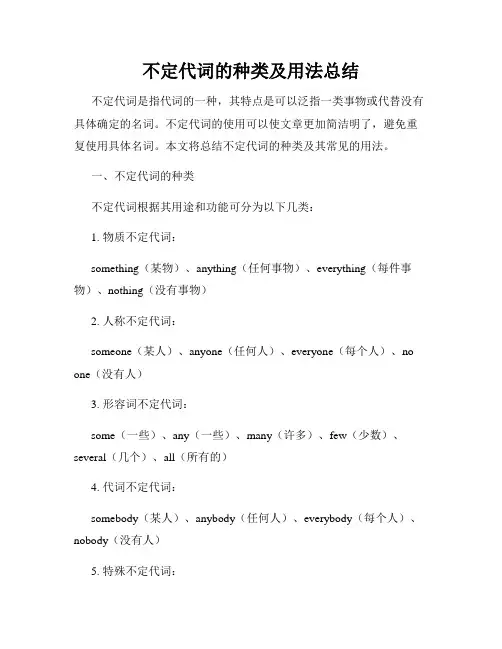
不定代词的种类及用法总结不定代词是指代词的一种,其特点是可以泛指一类事物或代替没有具体确定的名词。
不定代词的使用可以使文章更加简洁明了,避免重复使用具体名词。
本文将总结不定代词的种类及其常见的用法。
一、不定代词的种类不定代词根据其用途和功能可分为以下几类:1. 物质不定代词:something(某物)、anything(任何事物)、everything(每件事物)、nothing(没有事物)2. 人称不定代词:someone(某人)、anyone(任何人)、everyone(每个人)、no one(没有人)3. 形容词不定代词:some(一些)、any(一些)、many(许多)、few(少数)、several(几个)、all(所有的)4. 代词不定代词:somebody(某人)、anybody(任何人)、everybody(每个人)、nobody(没有人)5. 特殊不定代词:each(每个)、either(任何一个)、neither(两者都不)、both(两者都)二、不定代词的用法1. 泛指不定代词:不定代词可以用来泛指一类事物,如:something、anything、everything、nothing。
它们在句子中作主语、宾语或表语时,能够表示泛指、不确定或无所指的意义。
例如:- Something is wrong with the computer.(电脑出了问题。
)- I don't want to buy anything today.(我今天不想买任何东西。
)- She knows everything about fashion.(她对时尚了如指掌。
)- There is nothing better than a good book.(没有什么比一本好书更好了。
)2. 人称不定代词:人称不定代词用来泛指某个人,如:someone、anyone、everyone、no one。
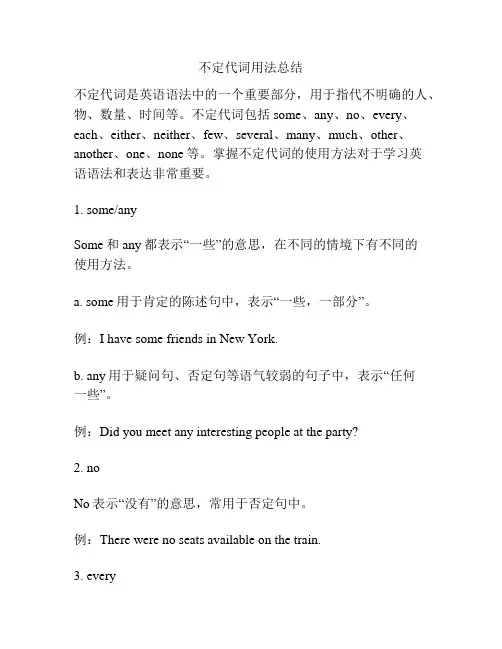
不定代词用法总结不定代词是英语语法中的一个重要部分,用于指代不明确的人、物、数量、时间等。
不定代词包括some、any、no、every、each、either、neither、few、several、many、much、other、another、one、none等。
掌握不定代词的使用方法对于学习英语语法和表达非常重要。
1. some/anySome和any都表示“一些”的意思,在不同的情境下有不同的使用方法。
a. some用于肯定的陈述句中,表示“一些,一部分”。
例:I have some friends in New York.b. any用于疑问句、否定句等语气较弱的句子中,表示“任何一些”。
例:Did you meet any interesting people at the party?2. noNo表示“没有”的意思,常用于否定句中。
例:There were no seats available on the train.3. everyEvery表示“每一个”的意思。
例:Every student is required to attend the meeting.4. eachEach表示“每一个”,用于强调个体。
例:Each student is responsible for his or her own progress.5. either/neitherEither表示“两者中的任何一个”,neither表示“两者都不”。
例:You can choose either the blue or the red dress.例:Neither of us likes to cook.6. few/several/many/much这些代词都用于表示数量或程度。
a. few表示“很少,几乎没有”。
例:There were few people in the park on such a hot day.b. several表示“几个,若干”。
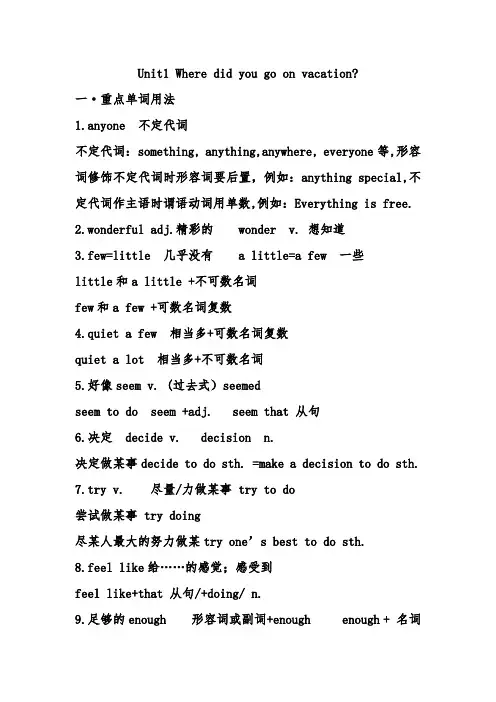
Unit1 Where did you go on vacation?一·重点单词用法1.anyone 不定代词不定代词:something, anything,anywhere, everyone等,形容词修饰不定代词时形容词要后置,例如:anything special,不定代词作主语时谓语动词用单数,例如:Everything is free.2.wonderful adj.精彩的 wonder v. 想知道3.few=little 几乎没有 a little=a few 一些little和a little +不可数名词few和a few +可数名词复数4.quiet a few 相当多+可数名词复数quiet a lot 相当多+不可数名词5.好像seem v. (过去式)seemedseem to do seem +adj. seem that 从句6.决定 decide v. decision n.决定做某事decide to do sth. =make a decision to do sth.7.try v. 尽量/力做某事 try to do尝试做某事 try doing尽某人最大的努力做某try one’s best to do sth.8.feel like给……的感觉;感受到feel like+that 从句/+doing/ n.9.足够的enough 形容词或副词+enough enough + 名词10.不喜欢 dislike v. 同义词:hate 反义词:like/love不喜欢做某事 dislike doing sth.二.课文中的重点1.做某事很有乐趣have fun (doing sth.) = have a good time( doing sth.)=enjoy oneself (doing sth.)他们每天打排球很有乐趣。
They have fun playing basketball every day.=They have a good time playing basketball every day.=They enjoy themselves playing basketball every day. 2.到达。

新人教版八年级上册英语单元语法及知识点归纳-CAL-FENGHAI.-(YICAI)-Company One1新人教版八年级上册英语单元语法及知识点归纳Unit1 Where did you go on vacation?【重点语法】不定代词:不指名代替任何特定名词或形容词的代词叫做不定代词。
用法注意:1. some 和any +可数名/不可数名。
some 多用于肯定句,any多用于否定句、疑问句和条件从句。
有些问句中用some,不用any, 问话者希望得到对方肯定回答。
2. 由some, any, no, every 与 body, one, thing构成的复合不定代词作主语时,其谓语动词用三单。
3. 不定代词若有定语修饰,该定语要置于其后:如:something interesting【重点短语】1. buy sth for ab./ buy sb. sth 为某人买某物2. taste + adj. 尝起来……3. nothing...but + V.(原形) 除了……之外什么都没有4. seem + (to be) + adj 看起来5. arrive in + 大地方 / arrive at + 小地方到达某地6. decide to do sth. 决定做某事7. try doing sth. 尝试做某事 / try to do sth. 尽力做某事8. enjoy doing sth. 喜欢做某事9. want to do sth. 想去做某事10. start doing sth. 开始做某事=begin doing sth.11. stop doing sth. 停止做某事区分: stop to do sth. 停下来去做某事12. dislike doing sth. 不喜欢做某事14. so + adj + that + 从句如此……以至于……16. tell sb. (not) to do sth. 告诉某人(不要)做某事17. keep doing sth. 继续做某事18. forget to do sth. 忘记去做某事 / forget doing sth 忘记做过某事【词语辨析】1. take a photo/ take photos 拍照quite a few+名词复数“许多…”2. seem + 形容词看起来…... You seem happy today.seem + to do sth. 似乎/好像做某事 I seem to have a coldIt seems + 从句似乎..…. It seems that no one believe you.seem like ... 好像,似乎….. It seems like a good idea.3. arrive in +大地点= get to= reach+地点名“到达......”arrive at +小地点(注:若后跟地点副词here/there/home, 介词需省略,如: arrive here; get home)4. feel like sth 感觉像…feel doing sth. 想要做某事5. wonder(想知道)+疑问词(who, what, why)引导的从句。
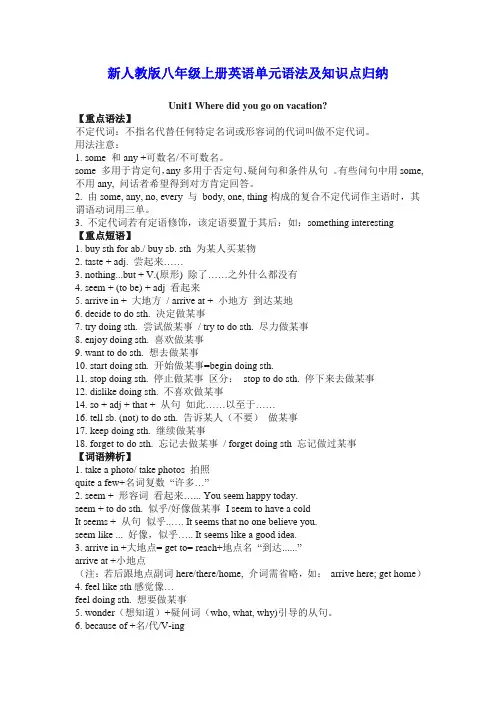
新人教版八年级上册英语单元语法及知识点归纳Unit1 Where did you go on vacation?【重点语法】不定代词:不指名代替任何特定名词或形容词的代词叫做不定代词。
用法注意:1. some 和any +可数名/不可数名。
some 多用于肯定句,any多用于否定句、疑问句和条件从句。
有些问句中用some,不用any, 问话者希望得到对方肯定回答。
2. 由some, any, no, every 与body, one, thing构成的复合不定代词作主语时,其谓语动词用三单。
3. 不定代词若有定语修饰,该定语要置于其后:如:something interesting【重点短语】1. buy sth for ab./ buy sb. sth 为某人买某物2. taste + adj. 尝起来……3. nothing...but + V.(原形) 除了……之外什么都没有4. seem + (to be) + adj 看起来5. arrive in + 大地方/ arrive at + 小地方到达某地6. decide to do sth. 决定做某事7. try doing sth. 尝试做某事/ try to do sth. 尽力做某事8. enjoy doing sth. 喜欢做某事9. want to do sth. 想去做某事10. start doing sth. 开始做某事=begin doing sth.11. stop doing sth. 停止做某事区分:stop to do sth. 停下来去做某事12. dislike doing sth. 不喜欢做某事14. so + adj + that + 从句如此……以至于……16. tell sb. (not) to do sth. 告诉某人(不要)做某事17. keep doing sth. 继续做某事18. forget to do sth. 忘记去做某事/ forget doing sth 忘记做过某事【词语辨析】1. take a photo/ take photos 拍照quite a few+名词复数“许多…”2. seem + 形容词看起来…... You seem happy today.seem + to do sth. 似乎/好像做某事I seem to have a coldIt seems + 从句似乎..…. It seems that no one believe you.seem like ... 好像,似乎….. It seems like a good idea.3. arrive in +大地点= get to= reach+地点名“到达......”arrive at +小地点(注:若后跟地点副词here/there/home, 介词需省略,如:arrive here; get home)4. feel like sth 感觉像…feel doing sth. 想要做某事5. wonder(想知道)+疑问词(who, what, why)引导的从句。
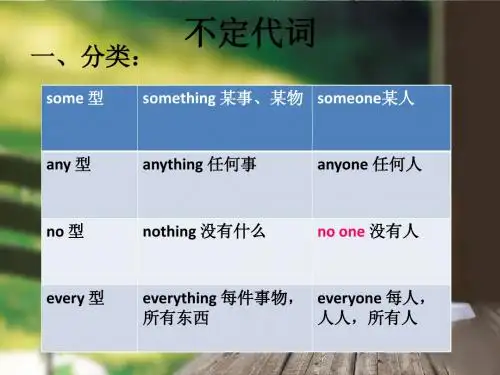
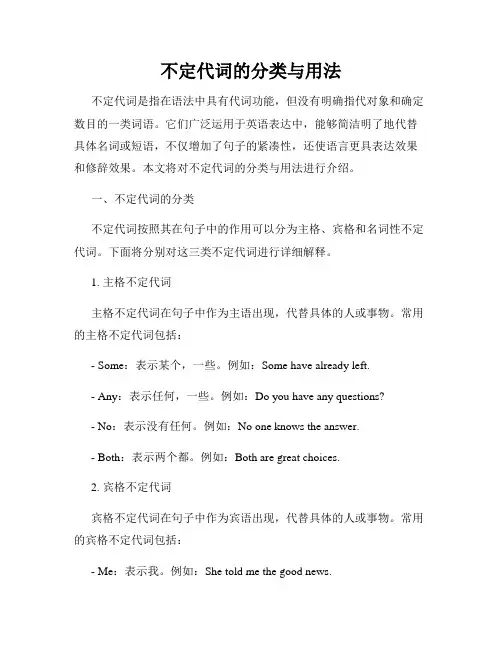
不定代词的分类与用法不定代词是指在语法中具有代词功能,但没有明确指代对象和确定数目的一类词语。
它们广泛运用于英语表达中,能够简洁明了地代替具体名词或短语,不仅增加了句子的紧凑性,还使语言更具表达效果和修辞效果。
本文将对不定代词的分类与用法进行介绍。
一、不定代词的分类不定代词按照其在句子中的作用可以分为主格、宾格和名词性不定代词。
下面将分别对这三类不定代词进行详细解释。
1. 主格不定代词主格不定代词在句子中作为主语出现,代替具体的人或事物。
常用的主格不定代词包括:- Some:表示某个,一些。
例如:Some have already left.- Any:表示任何,一些。
例如:Do you have any questions?- No:表示没有任何。
例如:No one knows the answer.- Both:表示两个都。
例如:Both are great choices.2. 宾格不定代词宾格不定代词在句子中作为宾语出现,代替具体的人或事物。
常用的宾格不定代词包括:- Me:表示我。
例如:She told me the good news.- You:表示你。
例如:They invited you to the party.- Them:表示他们/她们。
例如:I saw them at the concert.- It:表示它。
例如:I fed it some food.3. 名词性不定代词名词性不定代词在句子中作为主语、宾语、表语或同位语出现。
常用的名词性不定代词包括:- One:表示一个。
例如:Which one do you prefer?- Someone:表示某人,有人。
例如:Someone is waiting for you.- Something:表示某物,一些东西。
例如:I need something to eat.- Anybody:表示任何人,既可以指肯定句也可以指疑问句。
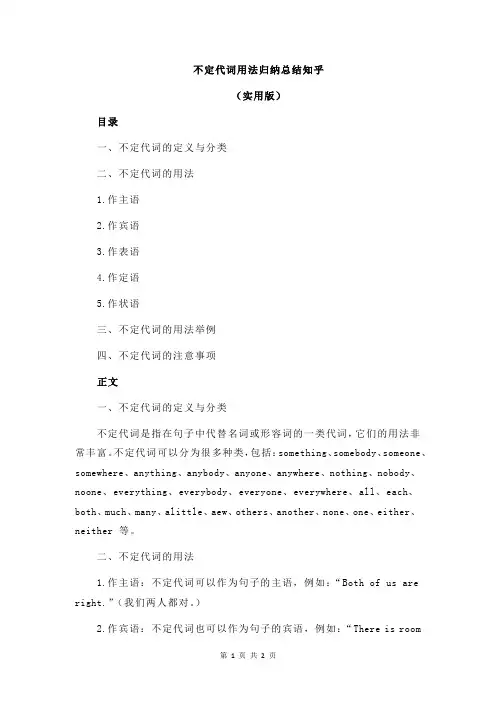
不定代词用法归纳总结知乎(实用版)目录一、不定代词的定义与分类二、不定代词的用法1.作主语2.作宾语3.作表语4.作定语5.作状语三、不定代词的用法举例四、不定代词的注意事项正文一、不定代词的定义与分类不定代词是指在句子中代替名词或形容词的一类代词,它们的用法非常丰富。
不定代词可以分为很多种类,包括:something、somebody、someone、somewhere、anything、anybody、anyone、anywhere、nothing、nobody、noone、everything、everybody、everyone、everywhere、all、each、both、much、many、alittle、aew、others、another、none、one、either、neither 等。
二、不定代词的用法1.作主语:不定代词可以作为句子的主语,例如:“Both of us are right.”(我们两人都对。
)2.作宾语:不定代词也可以作为句子的宾语,例如:“There is roomfor all of us.”(我们所有的人全坐得下。
)3.作表语:不定代词可以作为句子的表语,例如:“That"s nothing.”(没什么。
)4.作定语:不定代词可以作为句子的定语,例如:“You may take either road.”(两条路你走哪条都行。
)5.作状语:不定代词可以作为句子的状语,例如:“I can"t find my book anywhere.”(我在任何地方都不能找到我的书。
)三、不定代词的用法举例以下是一些不定代词在句子中的实际用法举例:- Both of them are teachers.(他们两人都是教师。
)- I know nothing about this person.(我对这个人一无所知。
)- This book is too much difficult for a child.(这本书对一个小孩来说太难了。
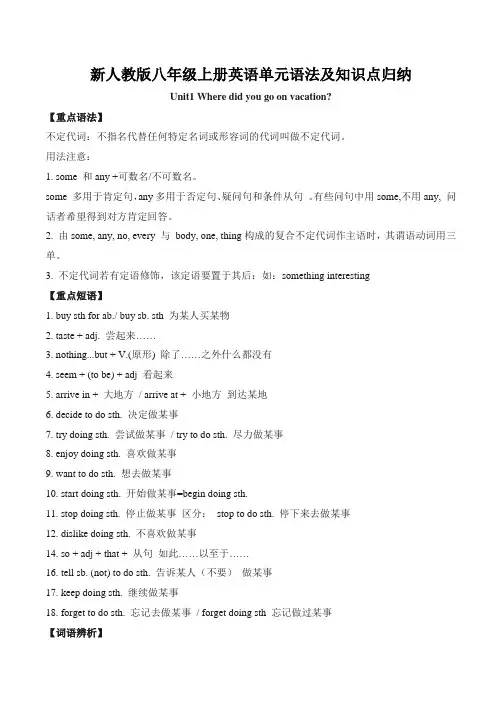
新人教版八年级上册英语单元语法及知识点归纳Unit1 Where did you go on vacation?【重点语法】不定代词:不指名代替任何特定名词或形容词的代词叫做不定代词。
用法注意:1. some 和any +可数名/不可数名。
some 多用于肯定句,any多用于否定句、疑问句和条件从句。
有些问句中用some,不用any, 问话者希望得到对方肯定回答。
2. 由some, any, no, every 与body, one, thing构成的复合不定代词作主语时,其谓语动词用三单。
3. 不定代词若有定语修饰,该定语要置于其后:如:something interesting【重点短语】1. buy sth for ab./ buy sb. sth 为某人买某物2. taste + adj. 尝起来……3. nothing...but + V.(原形) 除了……之外什么都没有4. seem + (to be) + adj 看起来5. arrive in + 大地方/ arrive at + 小地方到达某地6. decide to do sth. 决定做某事7. try doing sth. 尝试做某事/ try to do sth. 尽力做某事8. enjoy doing sth. 喜欢做某事9. want to do sth. 想去做某事10. start doing sth. 开始做某事=begin doing sth.11. stop doing sth. 停止做某事区分:stop to do sth. 停下来去做某事12. dislike doing sth. 不喜欢做某事14. so + adj + that + 从句如此……以至于……16. tell sb. (not) to do sth. 告诉某人(不要)做某事17. keep doing sth. 继续做某事18. forget to do sth. 忘记去做某事/ forget doing sth 忘记做过某事【词语辨析】1. take a photo/ take photos 拍照quite a few+名词复数“许多…”2. seem + 形容词看起来…... You seem happy today.seem + to do sth. 似乎/好像做某事I seem to have a coldIt seems + 从句似乎..…. It seems that no one believe you.seem like ... 好像,似乎….. It seems like a good idea.3. arrive in +大地点= get to= reach+地点名“到达......”arrive at +小地点(注:若后跟地点副词here/there/home, 介词需省略,如:arrive here; get home)4. feel like sth 感觉像…feel doing sth. 想要做某事5. wonder(想知道)+疑问词(who, what, why)引导的从句。

英语八年级上册知识讲义不定代词(Units1-2语法归纳)-人教新目标版知识梳理:【教材原句】Did you go with anyone? 你和其他人一起去的吗?No. No one was here. Everyone was on vacation. 不。
没人在这儿。
大家都在度假。
Everything tasted really good! 一切尝起来都很棒!【概念】不指明代替任何特定名词或形容词的代词叫不定代词。
【常见的不定代词】everything 每件事;一切1. some系列的词主要用于肯定句中;any系列的词主要用于疑问句、否定句中。
它们都既可修饰可数名词,也可修饰不可数名词。
【例句】There is something wrong with her. 她生病了。
There isn’t anyone in the classroom. 教室里没有人。
提示:在Would you like sth.?一类的问句中用some,不用any。
2. 由some, any, no, every构成的复合不定代词作主语时,谓语动词用第三人称单数形式。
【例句】Everyone in China likes the Spring Festival. 在中国,人人都喜欢春节。
3. 形容词修饰不定代词时,通常放在不定代词的后面。
【例句】Please do something special. 请做些特别的事情吧。
4. 几组不定代词的区别:① both, either, neither这三个词都指两者,both表示“两者都”,either表示“两者中的任何一个”,neither表示“两者都不”。
【例句】—Which do you like better, tea or coffee? 你更喜欢哪个,茶还是咖啡?—Neither, I like water better. 两者都不,我更喜欢水。
② a few; few;a little; little★ a few, few用来修饰可数名词,a little, little用来修饰不可数名词。
八年级上册英语各单元知识点大归纳Unit 1 Where did you go on vacation?【语法解析】不定代词:不指名代替任何特定名词或形容词的代词叫做不定代词。
用法注意:1. some 和any +可数名/不可数名。
some 多用于肯定句,any多用于否定句、疑问句和条件从句。
有些问句中用some,不用any, 问话者希望得到对方肯定回答。
2. 由some, any, no, every 构成的复合不定代词作主语时,其谓语动词用第三单3. 不定代词若有定语修饰,该定语要置于其后:如:something interesting二、知识点:1. buy sth for ab./ buy sb. sth 为某人买某物2. taste + adj. 尝起来……3. nothing ….but + V.(原形) 除了……之外什么都没有4. seem + (to be) + adj 看起来5. arrive in + 大地方 / arrive at + 小地方到达某地6. decide to do sth. 决定做某事7. try doing sth. 尝试做某事 / try to do sth. 尽力做某事8. enjoy doing sth. 喜欢做某事 9. want to do sth. 想去做某事10. start doing sth. 开始做某事=begin doing sth.11. stop doing sth. 停止做某事区分: stop to do sth. 停下来去做某事12. dislike doing sth. 不喜欢做某事14. so + adj + that + 从句如此……以至于……16. tell sb. (not) to do sth. 告诉某人(不要)做某事17. keep doing sth. 继续做某事18. forget to do sth. 忘记去做某事 / forget doing sth 忘记做过某事词语辨析:1. take a photo/ take photos 拍照quite a few+名词复数“许多…”2. seem 形容词看起来….. You seem happy today.to do sth. 似乎、好像做某事 I seem to have a coldIt seems + 从句似乎…. It seems that no one believe you.seem like ….好像,似乎….. It seems like a good idea.3. arrive in +大地点,= get to= reach+地点名“到达...”arrive at +小地点(注:若后跟地点副词here/there/home, 介词需省略,如:arrive here; get home)4. feel like sth/ doing sth. 感觉像是…5. wonder “想知道”,+疑问词(who, what, why)引导的从句。
人教版八年级英语上册单词-短语-句型和语法总结Unit1 Where did you go on vacation?【重点语法】不定代词:不指名代替任何特定名词或形容词的代词叫做不定代词。
用法注意:1. some 和any +可数名/不可数名。
some 多用于肯定句,any多用于否定句、疑问句和条件从句。
有些问句中用some,不用any, 问话者希望得到对方肯定回答。
2. 由some, any, no, every 与body, one, thing构成的复合不定代词作主语时,其谓语动词用三单。
3. 不定代词若有定语修饰,该定语要置于其后:如:something interesting【重点短语】1. buy sth for ab./ buy sb. sth 为某人买某物2. taste + adj. 尝起来……3. nothing...but + V.(原形) 除了……之外什么都没有4. seem + (to be) + adj 看起来5. arrive in + 大地方/ arrive at + 小地方到达某地6. decide to do sth. 决定做某事7. try doing sth. 尝试做某事/ try to do sth. 尽力做某事8. enjoy doing sth. 喜欢做某事9. want to do sth. 想去做某事10. start doing sth. 开始做某事=begin doing sth.11. stop doing sth. 停止做某事区分:stop to do sth. 停下来去做某事12. dislike doing sth. 不喜欢做某事14. so + adj + that + 从句如此……以至于……16. tell sb. (not) to do sth. 告诉某人(不要)做某事17. keep doing sth. 继续做某事18. forget to do sth. 忘记去做某事/ forget doing sth 忘记做过某事【词语辨析】1. take a photo/ take photos 拍照quite a few+名词复数“许多…”2. seem + 形容词看起来…... You seem happ y today.seem + to do sth. 似乎/好像做某事 I seem to have a coldIt seems + 从句似乎..…. It seems that no one believe you.seem like ... 好像,似乎….. It seems like a good idea.3. arrive in +大地点= get to= reach+地点名“到达......”arrive at +小地点(注:若后跟地点副词here/there/home, 介词需省略,如:arrive here; get home)4. feel like sth 感觉像…feel doing sth. 想要做某事5. wonder(想知道)+疑问词(who, what, why)引导的从句。
不定代词总结一、不定代词some 与any 的用法区别一般说来,不定代词some 用于肯定句中,any 用于否定句和疑问句中。
但是,在表示请求、邀请或征求意见的句子中,通常要用some 而不用any:Would you like some cake? 吃点蛋糕吗?Why not buy some bread? 为什么不买些面包呢?Shall I get some chalk for you? 要我帮你拿些粉笔来吗?【说明】不定代词any 有时也用于肯定句中,此时表示“任何”:Any colour will do. 任何颜色都行。
Come any day you like. 随便哪天来都可以。
二、不定代词many 与much 的用法以及区别不定代词many 和much 都表示“许多”,但many 修饰或代替可数名词(复数),与few(少数)相对;而much 用来修饰或代替不可数名词(单数),与little(少量)相对。
在口语中两者主要用于非肯定句中:Did you see many people there? 你在那儿看见许多人了吗?We don’t have much time. 我们没有许多时间。
Much work has been done. 许多工作都已经做了。
You’ve given me too much. 你已给我太多了。
Take as many (much) as you want. 你要多少拿多少。
I asked her a great many questions. 我问了她许多问题。
辨析:too much;much too;too many1、too much常用作副词或代词,也可以用作形容词修饰不可数名词.如:Is watching TV too much good or bad for your health?电视看得太多对你的健康有益还是有害?You've given me too much.你给我的太多了.We've had too much rain lately.最近我们这里的雨下得太多了.2、much too常作副词,后接副词或形容词.如:He drove much too fast.他开车开得太快了.It is much too cold.天实在太冷了.3、too many常用作形容词,修饰可数名词复数.如:They built too many buildings last year.去年他们建了许多楼房.三、either、neither的用法以及区别1、用作副词。
如何正确使用不定代词不定代词是英语中常用的一类代词,用来代替不确定的人、物或事物。
正确使用不定代词对于提高语言表达的准确性及流畅性非常重要。
本文将介绍如何正确使用不定代词并提供一些常见的不定代词用法和示例。
一、不定代词的概念及作用不定代词即指代不确定的人、物或事物的代词。
它们在句子中充当名词,用以替代特定的人或物,起到简化表达和增加语言的流畅性的作用。
不定代词可以用来指代泛指的人或物、在句子中起到强调或提问的作用。
二、常见的不定代词及其用法1. “some”和“any”- “some”用于肯定句或表示请求、建议、邀请等语境中,并且通常用于可数名词的复数形式或不可数名词。
示例:I have some apples.(我有一些苹果。
)Would you like some tea?(你要喝点茶吗?)- “any”用于否定句和疑问句中,并且通常用于可数名词的复数形式或不可数名词。
示例:I don't have any money.(我没有钱。
)Do you have any questions?(你有什么问题吗?)2. “something”和“anything”- “something”用于肯定句中,表示某事或某物。
它可以用作主语、宾语或表语。
示例:I want to say something. (我想说一些事情。
)Is there something wrong?(有什么问题吗?)- “anything”用于否定句和疑问句中,表示任何事情或任何东西。
同样可以用作主语、宾语或表语。
示例:I don't have anything to wear.(我没有任何衣服可穿。
) Is there anything I can do for you?(有什么我可以帮你的吗?)3. “somebody”和“anybody”- “somebody”用于肯定句中,表示某人。
它可以用作主语或宾语。
示例:Somebody called your name.(有人喊你的名字。
八年级不定代词的用法总结不定代词是指不确定或未指定的代词,用于代替不确定的人或事物。
以下是八年级不定代词的用法总结:1. 不定代词作主语不定代词可以在句子中作主语,这时谓语动词要用单数形式。
- Somebody is using the phone in the next room.- Everyone likes to have a holiday.2. 不定代词作宾语不定代词可以在句子中作宾语,代替人或物。
- I didn't see anybody in the room.- I have something important to tell you.3. 不定代词作表语不定代词可以在句子中作表语,描述主语的性质或特征。
- That's nothing.- She is somebody in this company.4. 不定代词作定语不定代词可以在句子中作定语,修饰名词或代词。
- There is something wrong with my computer.- I need someone to help me with my homework.5. 不定代词的用法区别在使用不定代词时,需要注意以下区别:- some 和 any:some 用于肯定句和表示请求、建议的疑问句中;any 用于否定句和疑问句中。
- no 和 none:no 表示没有任何东西或人,相当于 not any;none 表示没有特定的东西或人,强调数量为零。
- each 和 every:each 表示两个或两个以上的人或物中的每一个,强调个体;every 表示三个或三个以上的人或物中的每一个,强调整体。